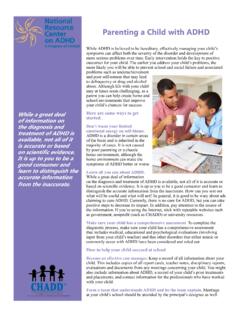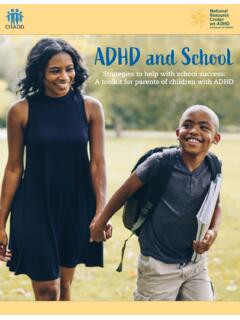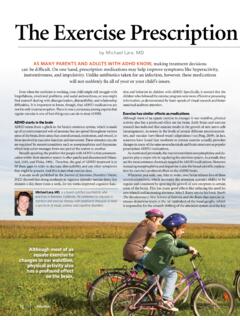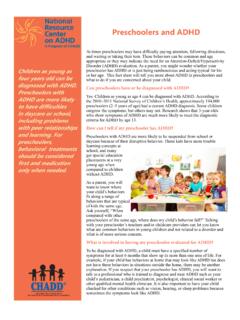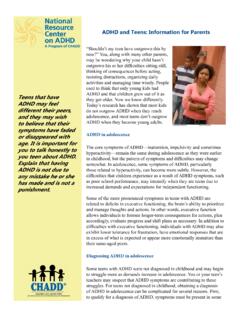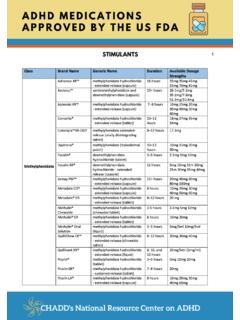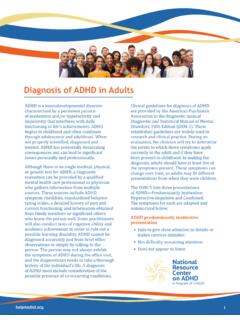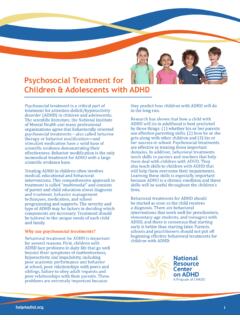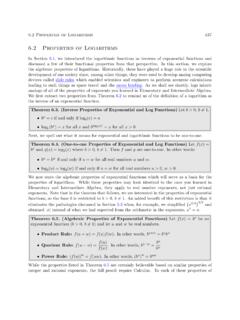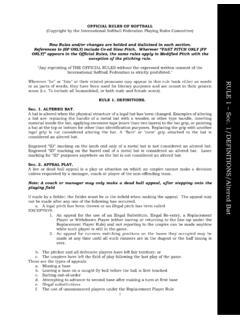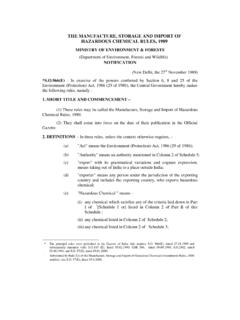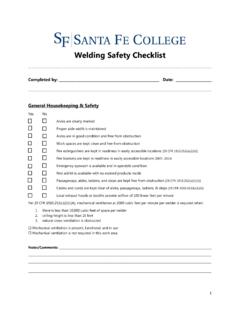Transcription of About ADHD - CHADD
1 About ADHD. Everybody can have difficulty sitting still, paying attention or controlling impulsive behavior More than 75 percent of children once in a while. For some people, however, the with ADHD continue to experience problems are so pervasive and persistent that significant symptoms in adulthood. they interfere with every aspect of their life: In early adulthood, ADHD may be home, academic, social and work. associated with depression, mood or conduct disorders and substance Attention-deficit/hyperactivity disorder abuse. (ADHD) is a neurodevelopmental disorder affecting 11 percent of school-age children Adults with ADHD often cope with (Visser, et al., 2014.) Symptoms continue into difficulties at work and in their adulthood in more than three-quarters of personal and family lives related to cases (Brown, 2013.) ADHD is characterized by ADHD symptoms. developmentally inappropriate levels of inattention, impulsivity and hyperactivity. ADHD. The current name reflects the importance Individuals with ADHD can be very successful of the inattention aspect of the disorder as well in life.
2 However, without identification and as the other c haracteristics of the disorder such proper treatment, ADHD may have s erious as hyperactivity and impulsivity. consequences, including school failure, family stress and disruption, depression, p roblems with Symptoms relationships, substance abuse, delinquency, Typically, ADHD symptoms arise in early accidental injuries and job failure. Early childhood. According to the DSM-5, several identification and treatment are e xtremely symptoms are required to be present before important. the age of 12. Many parents report excessive motor activity during the toddler years, but Medical science first documented c hildren ADHD symptoms can be hard to distinguish exhibiting inattentiveness, impulsivity and from the impulsivity, inattentiveness and active hyperactivity in 1902. Since that time, the behavior that is typical for kids u nder the age of disorder has been given numerous names, including minimal brain dysfunction, hyperkinetic reaction of childhood, and National attention-deficit disorder with or w ithout Resource hyperactivity.
3 With the Diagnostic and Statistical Center Manual, Fifth Edition (DSM-5) classification system, the disorder has been r enamed on ADHD. A Program of CHADD . attention-deficit/hyperactivity disorder or 1. four. In making the diagnosis, children should Since that time all forms of attention deficit have six or more symptoms of the d isorder disorder are officially called Attention-Deficit/ . present; adolescents 17 and older and adults Hyperactivity Disorder, regardless of whether should have at least five of the symptoms the individual has symptoms of hyperactivity or present. The DSM-5 lists three presentations of not. Even though these are the official labels, a ADHD Predominantly I nattentive, Hyperactive- lot of professionals and lay people still use both Impulsive and Combined. The symptoms for each terms: ADD and ADHD. Some use those terms to are adapted and summarized below. designate the old subtypes; others use ADD just as a shorter way to refer to any presentation. ADHD predominantly inattentive presentation Fails to give close attention to details or makes careless mistakes Has difficulty sustaining attention Does not appear to listen Struggles to follow through with instructions Has difficulty with organization Avoids or dislikes tasks requiring sustained mental effort Loses things Severity of symptoms Is easily distracted Is forgetful in daily activities As ADHD symptoms affect each person to varying degrees, the DSM-5 now requires ADHD predominantly hyperactive-impulsive professionals diagnosing ADHD to include the presentation severity of the disorder.
4 How severe the d isorder Fidgets with hands or feet or squirms in is can change with the presentation during chair a person's lifetime. Clinicians can designate Has difficulty remaining seated the s everity of ADHD as mild, moderate or Runs About or climbs excessively in children; severe under the criteria in the DSM-5. extreme restlessness in adults Mild: Few symptoms beyond the required Difficulty engaging in activities quietly number for diagnosis are present, and Acts as if driven by a motor; adults will often symptoms result in minor impairment in social, feel inside as if they are driven by a motor school or work settings. Talks excessively Blurts out answers before questions have Moderate: Symptoms or functional impairment been completed between mild and severe are present. Difficulty waiting or taking turns Severe: Many symptoms are present beyond Interrupts or intrudes upon others the number needed to make a diagnosis;. several symptoms are particularly severe; or ADHD combined presentation symptoms result in marked impairment in The individual meets the criteria for both social, school or work settings.
5 As individuals inattention and hyperactive-impulsive ADHD age, their symptoms may lessen, change or presentations. take different forms. Adults who retain some of the symptoms of childhood ADHD, but not These symptoms can change over time, so chil- all, can be diagnosed as having ADHD in partial dren may fit different presentations as they get remission. older. ADHD throughout the lifespan Confusing labels for ADHD. Children with ADHD often experience delays In 1994, the name of the disorder was changed in independent functioning and may behave in a way that is confusing for many people. younger than their peers. Many children affected 2. by ADHD can also have mild delays in language, and working memory. Recently, deficits in motor skills or social development that are not executive function have emerged as key f actors part of ADHD but often co-occur. They tend affecting academic and career s uccess. E xecutive to have low frustration tolerance, difficulty function is the brain's ability to prioritize and controlling their emotions and often experience manage thoughts and actions.
6 This a bility mood swings. permits individuals to consider the l ong-term consequences of their actions and guide Children with ADHD are at risk for p otentially their behavior across time more e ffectively. serious problems in adolescence and adulthood: Individuals who have issues with executive academic failure or delays, d riving problems, functioning may have d ifficulties completing difficulties with peers and s ocial situations, tasks or may forget important things. risky sexual behavior, and substance abuse. There may be more severe negative behaviors Co-occurring Disorders with co- existing conditions such as oppositional defiant disorder or c onduct disorder. Adolescent More than two-thirds of children with ADHD. girls with ADHD are also more prone to eating have at least one other co-existing condition. disorders than boys. As noted above, ADHD Any disorder can co-exist with ADHD, but persists from childhood to adolescence in the certain disorders seem to occur more often.
7 Vast majority of cases (50 80 percent), although These d isorders include oppositional defiant the hyperactivity may lessen over time. and conduct disorders, anxiety, depression, tic disorders or Tourette syndrome, substance abuse, sleep disorders and learning d isabilities. When co-existing conditions are present, academic and behavioral problems, as well as emotional issues, may be more complex. These co-occurring disorders can c ontinue throughout a person's life. A thorough d iagnosis and treatment plan that takes into account all of the symptoms present is e ssential. Teens with ADHD present a special challenge. Causes During these years, academic and life demands increase. At the same time, these kids face typical Despite multiple studies, researchers have adolescent issues such as emerging sexuality, yet to determine the exact causes of ADHD. establishing independence, dealing with peer However, scientists have discovered a strong pressure and the challenges of driving.
8 Genetic link since ADHD can run in families. More than 20 genetic studies have shown evidence More than 75 percent of children with ADHD that ADHD is strongly inherited. Yet ADHD is a continue to experience significant symptoms complex disorder, which is the result of multiple in adulthood. In early adulthood, ADHD may be interacting genes. (Cortese, 2012.). associated with depression, mood or c onduct disorders and substance abuse. Adults with Other factors in the environment may increase ADHD often cope with difficulties at work and in the likelihood of having ADHD: their personal and family lives related to ADHD exposure to lead or pesticides in early symptoms. Many have inconsistent performance childhood at work or in their careers; have difficulties premature birth or low birth weight with day-to-day responsibilities; e xperience brain injury relationship problems; and may have chronic feelings of frustration, guilt or blame. Scientists continue to study the exact Individuals with ADHD may also have difficulties relationship of ADHD to environmental factors, with maintaining attention, executive function but point out that there is no single cause that 3.
9 Explains all cases of ADHD and that many f actors may play a part. Previously, scientists believed that maternal stress and smoking during pregnancy could increase the risk for ADHD, but emerging evidence is starting to question this belief (Thapar, 2013.) However, further research is needed to determine if there is a link or not. Determining if a child has ADHD is a complex The following factors are NOT known causes, process. Many biological and psychological but can make ADHD symptoms worse for some problems can contribute to symptoms s imilar children: to those exhibited by children with ADHD. watching too much television For example, anxiety, depression and c ertain eating sugar types of learning disabilities may cause s imilar family stress (poverty, family conflict) symptoms. In some cases, these o ther c onditions traumatic experiences may actually be the primary diagnosis; in o thers, these conditions may co-exist with ADHD. A. ADHD symptoms, themselves, may contribute to thorough history should be taken from the family conflict.
10 Even though family stress does parents and teachers, and when appropriate, not cause ADHD, it can change the way the ADHD from the child. Checklists for rating ADHD. presents itself and result in additional problems symptoms and ruling out other disabilities are such as antisocial behavior (Langley, Fowler et often used by clinicians; these instruments al., 2010.) factor in age-appropriate behaviors and show when symptoms are extreme for the child's Problems in parenting or parenting styles developmental level. may make ADHD better or worse, but these do not cause the disorder. ADHD is clearly For adults, diagnosis also involves gathering a neurodevelopmental disorder. Currently information from multiple sources, which can research is underway to better define the areas include ADHD symptom checklists, standardized and pathways that are involved. behavior rating scales, a detailed history of past and current functioning, and information Diagnosis obtained from family members or significant others who know the person well.

